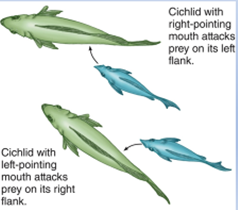Chapter 19: Evolutionary Change in Populations
1/35
There's no tags or description
Looks like no tags are added yet.
Name | Mastery | Learn | Test | Matching | Spaced |
|---|
No study sessions yet.
36 Terms
Balanced polymorphism
a type of genetic polymorphism in which two or more alleles persist in a population as a result of natural selection
Bottleneck effect
a random event that rapidly and dramatically decreases the size of a population
Directional selection
natural selection selects against one of the phenotypic extremes and favors the intermediates and other phenotypic extreme
Disruptive selection
natural selection selects against the intermediates and favors the phenotypic extremes
Founder effect
when a small group of individuals starts a new colony and the new population arises from that original group; as a result, the group exhibits little genetic variation
Frequency dependent selection
works to preserve balanced polymorphism; occurs when the frequency of a phenotype in a population determines the fitness of that trait
Genetic drift
a change in allele frequencies from one generation to the next
Genetic polymorphism
genetic variation among individuals of a population
Geographic variation (cline)
difference in genotype and phenotype frequencies in a population as a result of an environmental gradient (altitude for example)
Heterozygote advantage
works to preserve balanced polymorphism; occurs when the heterozygote has a higher level of fitness than either homozygote
Inbreeding
mating of genetically similar or genetically close individuals
Stabilizing selection
natural selection selects against phenotypic extremes and favors intermediate phenotypes
The overuse of antibiotics has led to a form of antibiotic-resistant tuberculosis. This has occurred as a result of ______.
A.) directional selection within the bacterial population
B.) stabilizing selection within the bacterial population
C.) disruptive selection within the bacterial population
D.) balanced polymorphism within the bacterial population
E.) a heterozygote advantage within the bacterial population
A.) directional selection within the bacterial population
Microevolutionary change in populations
-generation-to-generation (short time period)=small changes
-Allele or genotype frequencies (single or a few genes) are affected =get new appendages, body structures, etc.
-Result= over time, accumulation of changes leads to new species (macroevolution)
Five microevolutionary processes
-nonrandom mating
-mutation
-genetic drift
-gene flow
-natural selection
Nonrandom Mating
(assortative mating by phenotype) changes genotype frequency
Assortative Mating by Phenotype
-positive assortment: selection for similar phenotype
-negative assortment: selection for opposite/non-similar phenotype
-result: genotype frequency changes at loci involved in mate choice
Inbreeding and what happens?
occurs when mating individuals are more closely related than if random selection from general population
-overall allele frequencies do not change, homozygosity increases (decrease variability) → inbreeding depression
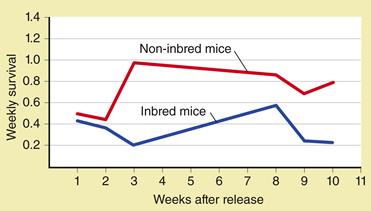
Inbreeding Depression
Noninbred goes down because of carrying capacity: inbred unwell (same circumstances)
Nonrandom Mating: selective Breeding
All biological species grouped so all can produce fertile offspring
Mutation
Spontaneous, non-directed changes in DNA sequences (heritable if in germ cell) that increases variation within a population
-create new alleles and alter allele frequency
Result: affect fitness (increase, decrease, or stay same) or significantly alter polypeptide and change function (harmful)
Explain genetic drift
random events change allele frequency (has most impact within small populations)
no specific selection of involvement of natural selection
low frequency allele could be completely lost by chance
frequency of other alleles could increase
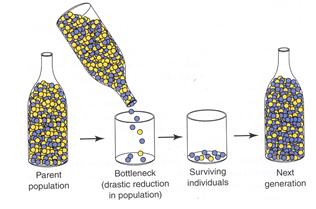
Bottleneck effect
(genetic drift can occur following a bottleneck)
Random, rapid decrease in population size because of disease, over harvesting, sudden environmental change, etc.
-result: genetic drift if number decrease too far. During expansion of remaining population, alleles may be: over or underrepresented or eliminated entirely-
Founder Effect
(genetic drift can occur as a result of the founder affect)
Few individuals or a larger population found a new colony
Result on alleles: only alleles of colonizers in a new population, frequency usually quite different from initial parent population
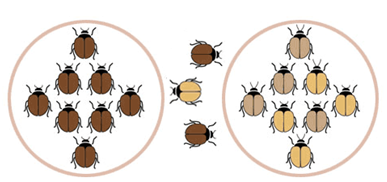
Gene Flow: define, when does it occur, results
(generally increases variation within population)
-movement of breeding individuals between two population
Results: increase genetic variability in recipient population, increase genetic similarity in populations involved, counteracts natural selection and genetic drift (in single population)
Natural Selection Result
Individuals better adapted to environment have greater fitness (eliminates unfavorable phenotypes), eventually favorable alleles increase (many traits are polyallelic)
-impacts phenotype distribution curve (bell-shape curve)
Modes of natural selection: Normal distribution
Normal distribution of phenotypes in absence of selective pressure

Modes of natural selection: stabilizing selection
Detrimental to Homozygous, beneficial to heterozygous (selection against extremes=variation reduced)
ex: natural childbirth
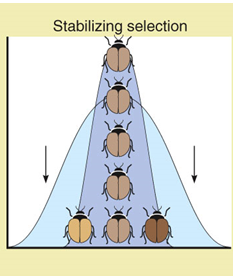
Modes of natural selection: directional selection
selective pressure unfavorable to phenotypes on one end of the curve=reestablish in shifted location
-one side of the curve is detrimental (ex: horses)
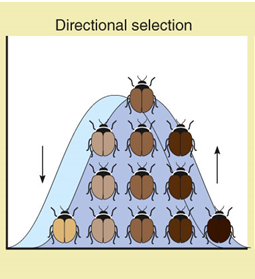
Modes of natural selection: Disruptive Selection
Environment favors coloration at both ends of distribution and is unfavorable to intermediate color range= possibility for new populations
-work in favor of homozygous, against heterozygous
Result: turn into 2 different species from initial group
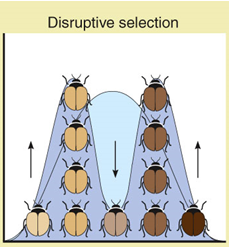
Maintaining genetic variation in populations (mutation and sexual reproduction)
Mutation: only when in gametes (heritable)= may or may not help
Sexual Reproduction: different parental alleles (maintain genetic variability) and recombining mutations in new ways
Genetic Polymorphism
helps maintain diversity
-genetic variability in phenotype between members of a population (multiple alleles)
Examples of Genetic Polymorphism
slight variations in amino acid sequences of an enzyme (same kinetics): A,B,O blood groups
-3 basic types but can be combined: allele frequence help with variability
Balanced polymorphism
Natural selection maintains two or more alleles in a population
Want to keep diversity: the number of one type could go down/up but not disappear or dominate
Balanced polymorphism is maintained in two ways:
Heterozygote advantage
frequency-dependent selection
Heterozygote Advantage
Natural selection maintains unfavorable alleles in homozygous state when heterozygote Aa has a higher degree of fitness that either homozygous AA or aa
Ex: gene for sickle cell anemia
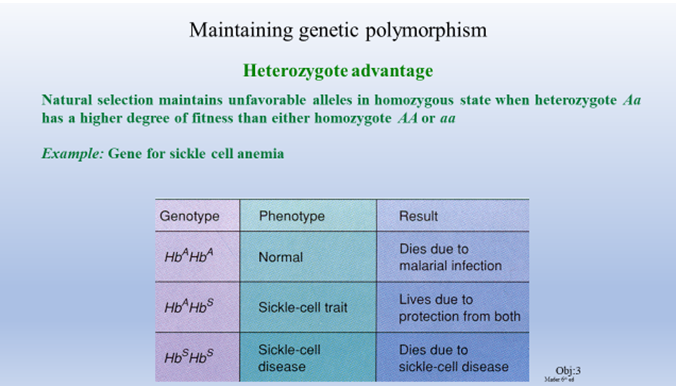
Frequency-dependent selection
Phenotype has greater selective value when rare than when common, this helps maintain variability
Ex: parasitic fish
